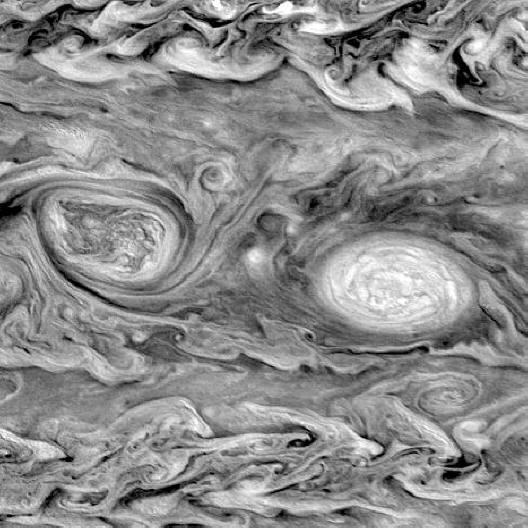|
|
What is Truth?
May 27, 2009
Astronomical research in the virtual
realm instigates foregone
conclusions.
The Thunderbolts Picture of the Day
has never considered questions that
involve the search for subjective
meaning in the universe to be
necessary when analyzing the
observations that NASA and other
research groups provide. It is
enough in most instances to draw
correspondence between the theories
proposed in peer-reviewed journals
and the concepts embodied in
Electric Universe hypotheses. The
so-called anomalies in consensus
opinions tend to disappear in most
cases when EU theory is brought to
bear on the questions.
A
recent article in the scientific
press highlights the disparity
between the conclusions that should
be drawn from observations and those
that are drawn from within the
imagination.
"Jupiter has a rocky core that is
more than twice as large as
previously thought, researchers
announced today."
On its face the headline is not
unusual and seems to indicate that
evidence has been uncovered
supporting a previously held theory.
Not only that, the previous theory
is tacitly assumed to have been
correct because new information is
enabling them to amplify its
conclusions. However, when the
announcement is fleshed-out the
headline has no basis in evidence at
all:
"Burkhard Militzer, a geophysicist
at the University of California,
Berkeley, and his colleagues ran
computer simulations to look at
conditions inside Jupiter... With
information gleaned from these
simulations, the researchers
developed another computer model..."
The subtitle of a
previous Picture of the Day
read:
"Extreme magnetic fields in space
are said to be caused by the
high-speed rotation of neutron
stars. One of many cases where a
theory is built on the incorrect
assumptions of another theory."
The University of California press
release continues:
"The large, rocky core implies that
as Jupiter and other giant gas
planets formed 4.5 billion years
ago, they grew through the collision
of small rocks that formed cores
that captured a huge atmosphere of
hydrogen and helium."
Once more NASA scientists are
constructing a will-o'-the-wisp out
of the ectoplasm generated by a
previous excursion into computer
models and equations. The way that
"simulations" are used to describe
hypothetical conditions as if the
algorithms are actualities instead
of the other way around is a symptom
of the upside down methods that are
being employed in the research
community today.
This begs our initial question:
"What is truth?" In the
"correspondence view" of truth, any
statement is true if it corresponds
to factual reality. An assertion
such as "there is a red fox in the
garden" is true only if there is
"actually" a red fox in the garden.
In this case, the corollary is not
true. Saying "there is no red fox in
the garden" does not correspond to a
true condition of fact when the red
fox is standing amidst the verge.
The correspondence view requires
that statements can be proven false
if they disagree with "real"
conditions. The EU hypothesis rests
its premises in that foundation, so
there is no mention of the beginning
of things—no speculation into the
origin of the universe or where the
energy comes from that sustains it.
Reflecting once more on the press
release about Jupiter, how does one
create conditions within computer
simulations that can be proven to
agree or disagree with real
conditions inside its chaotic
atmosphere? Do we now construct
manifold algorithms that demonstrate
how Jupiter's core is not big and
rocky? What then? On what basis can
the theoretical model ever be tested
when no man-made object can survive
the conditions inside Jupiter no
matter which theory is used?
The most important issue separating
the Electric Universe from
conventional views is that evidence
based in laboratory experiments can
be used to support EU theories of
cosmogony. The mainstream sinks its
foundations in ground where computer
models and complex equations are
used for support. It is this
philosophical divergence that
inhibits the general acceptance of
plasma and electricity as active
agents in space.
By Stephen Smith
|
|
|
|
|
|
SPECIAL NOTE - **New Volumes Available:
We are pleased to announce a new
e-book series
THE UNIVERSE ELECTRIC. Available now, the first volume
of this series, titled Big Bang, summarizes the failure of modern cosmology
and offers a new electrical perspective on the cosmos. At
over 200 pages, and
designed for broadest public appeal, it combines spectacular
full-color graphics with lean and readily understandable
text.
**Then second and third volumes in the series are now available,
respectively titled Sun and Comet, they offer
the reader easy to understand explanations of how and why these bodies
exist within an Electric Universe.
High school and college students--and teachers in
numerous fields--will love these books. So will a large
audience of general readers.
Visitors to the Thunderbolts.info site have often
wondered whether they could fully appreciate the Electric
Universe without further formal education. The answer is
given by these exquisitely designed books. Readers from
virtually all backgrounds and education levels will find them
easy to comprehend, from start to finish.
For the Thunderbolts Project, this series is a milestone.
Please see for yourself by checking out the new
Thunderbolts Project website, our leading edge in
reaching new markets globally.
Please visit our
Forum
|
|
|
|
|
|
|
|







